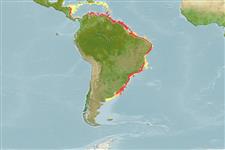Environment: milieu / climate zone / depth range / distribution range
Ekologi
laut; air tawar; payau; anadromus (ruaya dari laut ke air tawar) (Ref. 51243); kisaran kedalaman ? - 40 m (Ref. 5217). Subtropical; 19°N - 41°S, 88°W - 34°W (Ref. 101638)
Western Atlantic: Belize (but no southerly records until Lake Maracaibo, Venezuela); then from Gulf of Venezuela and Trinidad south to Argentina at Carmen de Patagones; also lower and sometimes middle parts of the Orinoco, the Amazon to above Manaus, and Paraná to about Corrientes, and in smaller rivers.
Length at first maturity / Size / Weight / umur
Maturity: Lm 11.2 range ? - ? cm
Max length : 23.5 cm SL jantan/; (Ref. 50628); common length : 20.0 cm TL jantan/; (Ref. 5217); Berat maksimum terpublikasi: 57.00 g (Ref. 118626)
Duri punggung (Keseluruhan (total)) : 0; duri punggung lunak (Keseluruhan (total)) : 13 - 14; Duri dubur: 0; Sirip dubur lunak: 21 - 28. Depth widely variable. Snout about 2/3 eye diameter; maxilla moderate, pointed, reaching onto sub-operculum. Gill rakers short, the longest not less than pupil diameter in adults. Dorsal fin origin behind midpoint of body; anal fin origin below 6th-8th branched dorsal fin rays. Silver stripe up to twice eye diameter at widest, lost in fishes over 10 cm SL. Curve of black dots on operculum (Ref. 189). Grayish blue dorsally, fins yellowish with translucent membranes and a blackish caudal margin (Ref. 27363).
Occurs in brackish estuaries and adjacent marine areas; penetrates freshwater (Ref. 5217). Forms moderate schools. Usually migrating from estuaries or the sea, but possibly the limnichthys of Lake Maracaibo and the amazonensis represent purely freshwater forms. In freshwater, it feeds principally on small fishes, prawns and copepods; also insect larvae. At sea, it feeds on fishes and various crustaceans. Spawns in freshwater. Year round occurrence of eggs reported.
Spawn in school (Ref. 205).
Whitehead, P.J.P., G.J. Nelson and T. Wongratana, 1988. FAO Species Catalogue. Vol. 7. Clupeoid fishes of the world (Suborder Clupeoidei). An annotated and illustrated catalogue of the herrings, sardines, pilchards, sprats, shads, anchovies and wolf-herrings. FAO Fish. Synop. 125(7/2):305-579. Rome: FAO. (Ref. 189)
Status IUCN Red List (Ref. 130435: Version 2024-1)
ancaman kepada manusia
Harmless
penggunaan manusia
Perikanan: nilai komersial kecil
Alat, peralatan
laporan khas
muat turun XML
Sumber internet
Estimates based on models
Preferred temperature (Ref.
123201): 15.1 - 28, mean 26.2 °C (based on 250 cells).
Phylogenetic diversity index (Ref.
82804): PD
50 = 0.5312 [Uniqueness, from 0.5 = low to 2.0 = high].
Bayesian length-weight: a=0.00575 (0.00469 - 0.00706), b=3.16 (3.10 - 3.22), in cm total length, based on LWR estimates for this species (Ref.
93245).
Trophic level (Ref.
69278): 3.7 ±0.67 se; based on food items.
Daya lenting (Ref.
120179): sedang, Waktu penggandaan populasi minimum 1.4 - 4.4 tahun (Assuming tmax>3).
Fishing Vulnerability (Ref.
59153): Moderate vulnerability (35 of 100).
Nutrients (Ref.
124155): Calcium = 117 [67, 246] mg/100g; Iron = 1.64 [0.93, 2.82] mg/100g; Protein = 19.7 [18.3, 21.2] %; Omega3 = 0.718 [0.413, 1.409] g/100g; Selenium = 15.1 [7.6, 31.0] μg/100g; VitaminA = 20.2 [6.2, 55.2] μg/100g; Zinc = 1.05 [0.73, 1.51] mg/100g (wet weight);
